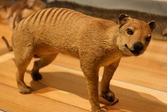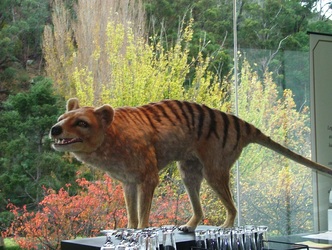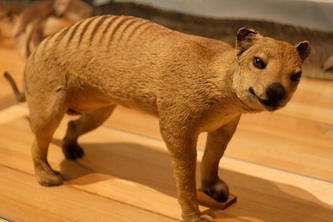
It is commonly known as the Tasmanian tiger (because of its striped back), the Tasmanian wolf, and colloquially the Tassie tiger or simply the tiger.[6] Native to continental Australia, Tasmania and New Guinea, it is thought to have become extinct in the 20th century. It was the last extant member of its genus, Thylacinus, although several related species have been found in the fossil record dating back to the early Miocene.
The thylacine had become extremely rare or extinct on the Australian mainland before European settlement of the continent, but it survived on the island of Tasmania along with several other endemic species, including the Tasmanian devil. Intensive hunting encouraged by bounties is generally blamed for its extinction, but other contributory factors may have been disease, the introduction of dogs, and human encroachment into its habitat. Despite its official classification as extinct, sightings are still reported, though none proven.
Like the tigers and wolves of the Northern Hemisphere, from which it obtained two of its common names, the thylacine was an apex predator. As a marsupial, it was not closely related to these placental mammals, but because of convergent evolution it displayed the same general form and adaptations. Its closest living relative is thought to be either the Tasmanian devil or numbat.
The thylacine was one of only two marsupials to have a pouch in both sexes (the other being the water opossum). The male thylacine had a pouch that acted as a protective sheath, covering the male's external reproductive organs while he ran through thick brush.
The thylacine had become extremely rare or extinct on the Australian mainland before European settlement of the continent, but it survived on the island of Tasmania along with several other endemic species, including the Tasmanian devil. Intensive hunting encouraged by bounties is generally blamed for its extinction, but other contributory factors may have been disease, the introduction of dogs, and human encroachment into its habitat. Despite its official classification as extinct, sightings are still reported, though none proven.
Like the tigers and wolves of the Northern Hemisphere, from which it obtained two of its common names, the thylacine was an apex predator. As a marsupial, it was not closely related to these placental mammals, but because of convergent evolution it displayed the same general form and adaptations. Its closest living relative is thought to be either the Tasmanian devil or numbat.
The thylacine was one of only two marsupials to have a pouch in both sexes (the other being the water opossum). The male thylacine had a pouch that acted as a protective sheath, covering the male's external reproductive organs while he ran through thick brush.
Thylacine or the Tasmanian tiger is not exactly like any regal tigers you have seen so far; in fact this tiger is a far cry from the normal tigers! Although now they are considered to be extinct, their existence is still in question due to many reported sightings by explorers. The Thylacine looks less of a tiger and more of a wolf and has few characteristics of a dog as well. This animal was seen in large numbers in the early days but soon their numbers declined due to hunting. The Thylacine sure seems to be one animal that is surrounded by mystery! Here, we shall have an insight into details connected with the Tasmanian tiger.
Description of the Thylacine – Tasmanian Tiger
The Thylacine was a marsupial – these are mammals that are distinguished from other animals due to the presence of a pouch, which is used to carry their young ones. In case of the Thylacine, males as well as females both had a pouch. This was mainly because for the male Tasmanian tiger, the pouch proved to be a form of protection to protect the external organs.
Early depictions of the Tasmanian tiger reveal a strong resemblance to dogs. This Tasmanian tiger looked like a shorthaired dog, which had a big head. It had been referred to as a tiger only because of the presence of stripes on the body. Tasmanian tigers had a yellowish brown colored coat for their body. A rather strange characteristic feature of the Tasmanian tiger was the ability to open its jaw wide to an angle of 120 degrees! It has also been reported this tiger did not really have the ability to run at a high speed. Studies revealed the Tasmanian tiger even hopped at times on the similar lines of a kangaroo!
On an average, the Thylacine was reported to be around 100 – 180 cms in length (from the nose to the tip of the tail) and stood at a height of 60 cms (at the shoulder area). They could weigh up to 30 kgs. The tail of the Tasmanian tiger was stiff and was thicker towards the base. The stripes of the Thylacine were around 15 – 20 in number, which went all across from the shoulder to the base of the tail.
Breeding and Behavior of the Thylacine – Tasmanian Tiger
Breeding period of the Thylacine took place during the winter and spring seasons. Young ones spent their time in the mother’s pouch. When these young ones left the mother’s pouch, they spent time in caves till they reached an age to hunt for themselves.
The Tasmanian tiger was known to be a nocturnal animal by nature. The days were spent in caves and the nights were spent hunting in the forests. The Tasmanian tiger used its strong sense of smell to capture prey in the dark. This animal is also known to be shy in nature. Experts have revealed the Tasmanian tiger preferred to pursue its prey by trotting behind rather than the powerful bursts of speed displayed by tigers.
Habitat of the Thylacine – Tasmanian Tiger
The Tasmanian tiger was native to the Australia and areas of New Guinea. This tiger was known to inhabit wetlands and the grassland areas. It also preferred eucalyptus forests. In areas of Tasmania, the Thylacine preferred to inhabit woodland areas. This was also indicated with the discovery of rock paintings that suggest the Tasmanian tiger lived in that particular area and was also seen approximately 2000 years back!
Mystery surrounding the Thylacine – Tasmanian Tiger
The Tasmanian tiger was reported to be extinct after the 1930s. There were many factors that led to the rapid decline of these animals. The loss of habitat, being hunted by humans and wild dogs led to their extinction. However, a great number of people in Tasmania have reported seeing the Tasmanian tiger in the wild. Although certain unclear photographs were provided, the authenticity of these photographs is still a matter of great debate!
Description of the Thylacine – Tasmanian Tiger
The Thylacine was a marsupial – these are mammals that are distinguished from other animals due to the presence of a pouch, which is used to carry their young ones. In case of the Thylacine, males as well as females both had a pouch. This was mainly because for the male Tasmanian tiger, the pouch proved to be a form of protection to protect the external organs.
Early depictions of the Tasmanian tiger reveal a strong resemblance to dogs. This Tasmanian tiger looked like a shorthaired dog, which had a big head. It had been referred to as a tiger only because of the presence of stripes on the body. Tasmanian tigers had a yellowish brown colored coat for their body. A rather strange characteristic feature of the Tasmanian tiger was the ability to open its jaw wide to an angle of 120 degrees! It has also been reported this tiger did not really have the ability to run at a high speed. Studies revealed the Tasmanian tiger even hopped at times on the similar lines of a kangaroo!
On an average, the Thylacine was reported to be around 100 – 180 cms in length (from the nose to the tip of the tail) and stood at a height of 60 cms (at the shoulder area). They could weigh up to 30 kgs. The tail of the Tasmanian tiger was stiff and was thicker towards the base. The stripes of the Thylacine were around 15 – 20 in number, which went all across from the shoulder to the base of the tail.
Breeding and Behavior of the Thylacine – Tasmanian Tiger
Breeding period of the Thylacine took place during the winter and spring seasons. Young ones spent their time in the mother’s pouch. When these young ones left the mother’s pouch, they spent time in caves till they reached an age to hunt for themselves.
The Tasmanian tiger was known to be a nocturnal animal by nature. The days were spent in caves and the nights were spent hunting in the forests. The Tasmanian tiger used its strong sense of smell to capture prey in the dark. This animal is also known to be shy in nature. Experts have revealed the Tasmanian tiger preferred to pursue its prey by trotting behind rather than the powerful bursts of speed displayed by tigers.
Habitat of the Thylacine – Tasmanian Tiger
The Tasmanian tiger was native to the Australia and areas of New Guinea. This tiger was known to inhabit wetlands and the grassland areas. It also preferred eucalyptus forests. In areas of Tasmania, the Thylacine preferred to inhabit woodland areas. This was also indicated with the discovery of rock paintings that suggest the Tasmanian tiger lived in that particular area and was also seen approximately 2000 years back!
Mystery surrounding the Thylacine – Tasmanian Tiger
The Tasmanian tiger was reported to be extinct after the 1930s. There were many factors that led to the rapid decline of these animals. The loss of habitat, being hunted by humans and wild dogs led to their extinction. However, a great number of people in Tasmania have reported seeing the Tasmanian tiger in the wild. Although certain unclear photographs were provided, the authenticity of these photographs is still a matter of great debate!




 RSS Feed
RSS Feed